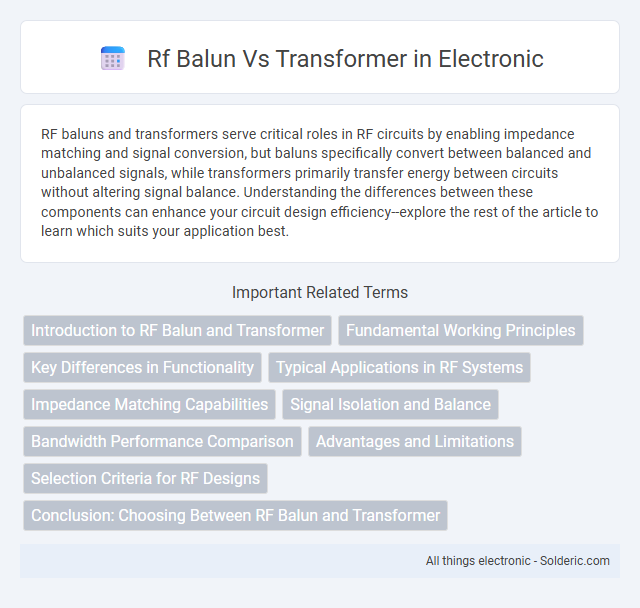RF baluns and transformers serve critical roles in RF circuits by enabling impedance matching and signal conversion, but baluns specifically convert between balanced and unbalanced signals, while transformers primarily transfer energy between circuits without altering signal balance. Understanding the differences between these components can enhance your circuit design efficiency--explore the rest of the article to learn which suits your application best.
Comparison Table
| Aspect | RF Balun | Transformer |
|---|---|---|
| Function | Converts between balanced and unbalanced signals | Changes voltage or current levels in AC signals |
| Application | Used in RF circuits, antennas, and transmission lines | Used in power supplies, impedance matching, and signal isolation |
| Frequency Range | Optimized for high-frequency RF signals (MHz to GHz) | Wide range, varies based on design, often lower frequency AC |
| Impedance Matching | Designed for impedance transformation between balanced/unbalanced lines | Primary role is impedance transformation between circuits |
| Construction | May use transmission lines, toroidal cores, or transmission transformers | Typically wound coils on magnetic cores (ferrite, iron) |
| Signal Type | Primarily RF signals | AC signals, including audio and power frequencies |
| Size | Usually compact for high-frequency applications | Size varies widely depending on power and frequency |
| Examples | 1:1 current balun for antenna feed lines | Step-up or step-down transformer in power supplies |
Introduction to RF Balun and Transformer
RF baluns and transformers are essential components in radio frequency systems, designed to manage signal impedance and convert between balanced and unbalanced signals. RF baluns specifically provide impedance matching and signal balancing to optimize transmission lines in antennas and RF circuits. Transformers, in contrast, primarily serve to transfer electrical energy between circuits while changing voltage levels and isolating signals within a wide range of frequencies.
Fundamental Working Principles
An RF balun operates by converting between balanced and unbalanced signals using a combination of transformers and transmission line techniques to maintain impedance matching and signal integrity. Transformers rely on magnetic coupling between coils to transfer energy and adjust voltage or current levels without altering signal balance. Your choice depends on the required frequency range and application, as baluns integrate both transformer action and impedance transformation for RF systems.
Key Differences in Functionality
RF baluns convert unbalanced signals to balanced signals and vice versa, enabling efficient impedance matching in RF circuits. Transformers primarily transfer electrical energy between two or more circuits through electromagnetic induction, focusing on voltage transformation rather than signal balancing. Your choice depends on whether the application requires signal balance or voltage transformation.
Typical Applications in RF Systems
RF baluns are commonly used in antenna systems, mixers, and amplifiers to convert unbalanced signals to balanced ones, ensuring signal integrity and reducing interference. Transformers serve primarily in impedance matching and isolation in RF circuits, such as in filters and power distribution networks. Your choice depends on the specific application requirements, including frequency range, signal type, and system design constraints.
Impedance Matching Capabilities
RF baluns provide superior impedance matching capabilities by converting unbalanced signals to balanced signals with minimal insertion loss, making them ideal for high-frequency applications. Transformers primarily focus on voltage transformation and may introduce more signal loss and phase distortion when used for impedance matching at radio frequencies. Balanced impedance matching in RF baluns ensures improved signal integrity and reduced electromagnetic interference compared to traditional transformers.
Signal Isolation and Balance
RF baluns provide superior signal isolation by converting unbalanced signals to balanced signals, minimizing common-mode noise and interference in high-frequency applications. Transformers can also offer signal isolation but may exhibit less effective balance, leading to potential signal distortion or unwanted coupling. High-performance RF baluns are specifically designed to maintain balance and achieve excellent isolation, critical for achieving optimal signal integrity in RF circuits.
Bandwidth Performance Comparison
RF baluns typically offer wider bandwidth performance compared to traditional transformers due to their design, which minimizes inductive and capacitive losses across frequencies. Transformer bandwidth is often limited by core material properties and winding capacitances, restricting its efficiency at higher frequencies. Your choice between an RF balun and transformer should consider the specific frequency range requirements to achieve optimal signal integrity and minimal insertion loss.
Advantages and Limitations
RF baluns provide excellent impedance matching and phase balance for differential signal conversion, enhancing signal integrity in high-frequency applications. Transformers offer robust isolation and can handle higher power levels but may introduce core saturation and bandwidth limitations. Your choice depends on whether balanced signal quality or power handling is more critical for your RF design.
Selection Criteria for RF Designs
Choosing between an RF balun and a transformer depends on factors such as impedance matching, frequency range, and insertion loss requirements in your RF design. RF baluns are ideal for converting balanced signals to unbalanced with minimal phase distortion and typically offer broader bandwidth performance. Transformers excel in power transfer and isolation but may introduce higher losses and limited frequency response, making careful consideration of application-specific criteria essential.
Conclusion: Choosing Between RF Balun and Transformer
Choosing between an RF balun and a transformer depends on the specific application requirements such as impedance matching, frequency range, and signal type. RF baluns excel in converting between balanced and unbalanced signals while maintaining signal integrity in RF circuits, particularly in antenna systems and differential signaling. Transformers provide voltage isolation and impedance transformation across a broader frequency spectrum but may introduce higher insertion loss and distortion in high-frequency RF applications.
rf balun vs transformer Infographic

 solderic.com
solderic.com